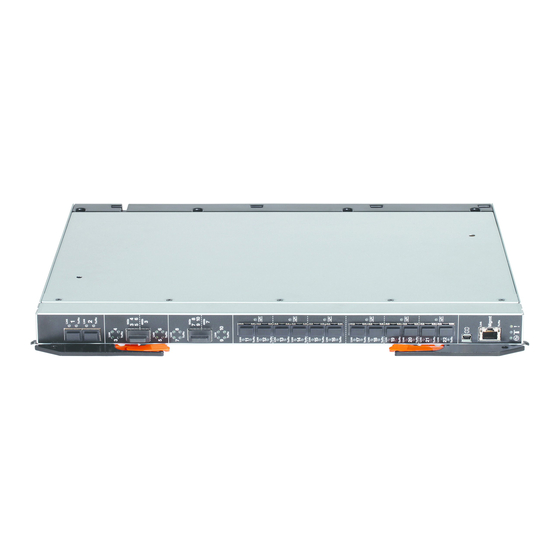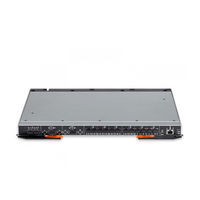
Lenovo Flex System Fabric CN4093 Manuals
Manuals and User Guides for Lenovo Flex System Fabric CN4093. We have 6 Lenovo Flex System Fabric CN4093 manuals available for free PDF download: Application Manual, Installation Manual, User Manual, Product Manual
Lenovo Flex System Fabric CN4093 Application Manual (634 pages)
How to configure and use the Enterprise NOS 8.4 software on the 10 Gb Converged Scalable Switch
Table of Contents
-
Preface21
-
-
Using Telnet33
-
BBI Summary38
-
Secure FTP51
-
Limitations56
-
-
IP Routing69
-
-
-
-
Authorization105
-
Backdoor106
-
Accounting106
-
-
ACL Groups125
-
Metering126
-
Re-Marking126
-
ACL Logging128
-
Log Interval129
-
ACL Example 1130
-
ACL Example 2130
-
ACL Example 3131
-
VLAN Maps132
-
Vmap Example133
-
Management Acls134
-
Chapter 8. Vlans
137-
Vlans Overview138
-
VLAN Numbers139
-
Limitations146
-
PVLAN Tagging151
-
Private Vlans153
-
-
-
Static Lags162
-
LACP Modes168
-
LACP Individual169
-
Configuring LACP170
-
-
PVRST Mode173
-
Port States173
-
Bridge Priority174
-
Port Priority175
-
Root Guard175
-
Loop Guard175
-
Port Path Cost176
-
Port States185
-
MSTP Region187
-
Link Type191
-
-
VLAG Capacities196
-
Vlags with VRRP205
-
-
-
Qos Overview215
-
Metering218
-
Re-Marking218
-
Per-Hop Behavior220
-
Qos Levels221
-
-
-
Stack Membership235
-
Master Failover238
-
Master Recovery238
-
No Backup239
-
Stacking Vlans241
-
Managing a Stack246
-
New Hybrid Stack248
-
New Stack248
-
-
Vnic Groups269
-
-
VE Capacity279
-
VM Group Types280
-
Local VM Groups280
-
VM Profiles282
-
Vmcheck284
-
Basic Validation284
-
Prerequisites286
-
Guidelines286
-
Migrating to Vds287
-
Vcenter Scans289
-
VLAN Maps291
-
Vcenter Ves295
-
-
-
Port Aggregation306
-
Fcoe ACL Rules308
-
Fcoe Vlans309
-
Priority Groups317
-
Pgid317
-
Configuring ETS320
-
DCBX Settings322
-
Configuring DCBX324
-
-
NPV Gateway331
-
Limitations332
-
Port Modes333
-
Port Membership334
-
Switching Mode335
-
NPV Gateway336
-
Limitations337
-
Full Fabric Mode338
-
Zones338
-
E-Ports341
-
Restrictions343
Advertisement
Lenovo Flex System Fabric CN4093 Application Manual (598 pages)
10Gb Converged Scalable Switch
Table of Contents
-
Preface
21 -
-
-
Using Telnet32
-
Secure FTP42
-
-
-
IP Routing58
-
-
-
-
ACL Groups107
-
-
Metering108
-
Re-Marking108
-
-
-
ACL Example 1110
-
ACL Example 2110
-
ACL Example 3111
-
-
VLAN Maps112
-
Vmap Example113
-
-
Management Acls114
-
Chapter 8. Vlans
117-
Vlans Overview118
-
-
VLAN Numbers119
-
-
-
-
Limitations126
-
-
-
Private Vlans133
-
-
-
Static Lags142
-
-
LACP Modes148
-
LACP Individual149
-
Configuring LACP150
-
-
-
PVRST Mode153
-
Port States153
-
-
Bridge Priority154
-
Port Priority155
-
Root Guard155
-
Loop Guard155
-
Port Path Cost156
-
-
-
Link Type171
-
-
VLAG Capacities176
-
-
-
-
Vlags with VRRP185
-
-
-
-
Qos Overview195
-
-
-
Metering198
-
Re-Marking198
-
-
-
-
Stack Membership214
-
Managing a Stack225
-
-
Vnic Groups249
-
-
VE Capacity259
-
VM Group Types260
-
Vmcheck264
-
Basic Validation264
-
-
-
Prerequisites266
-
Guidelines266
-
Migrating to Vds267
-
-
VLAN Maps271
-
-
Vcenter Ves275
-
-
-
-
-
Port Aggregation286
-
Fcoe ACL Rules288
-
Fcoe Vlans289
-
-
-
-
NPV Gateway310
-
Limitations311
-
-
-
Port Modes312
-
Port Membership313
-
Switching Mode314
-
NPV Gateway315
-
Full Fabric Mode317
-
-
Restrictions322
-
-
Lenovo Flex System Fabric CN4093 Installation Manual (72 pages)
10 Gb Converged Scalable Switch
Table of Contents
-
-
SFP+ Ports26
-
QSFP+ Ports29
-
-
Running POST56
-
POST Errors57
-
-
-
Trademarks63
-
Advertisement
Lenovo Flex System Fabric CN4093 User Manual (58 pages)
10 Gb Converged Scalable Switch
Table of Contents
-
-
SFP+ Ports24
-
QSFP+ Ports26
-
-
Running POST47
-
POST Errors47
-
-
-
Trademarks52
-
Lenovo Flex System Fabric CN4093 Product Manual (29 pages)
10Gb Converged Scalable Switch
Table of Contents
-
Warranty19
Lenovo Flex System Fabric CN4093 Product Manual (29 pages)
10Gb Converged Scalable Switch
Table of Contents
-
Warranty18
Advertisement





